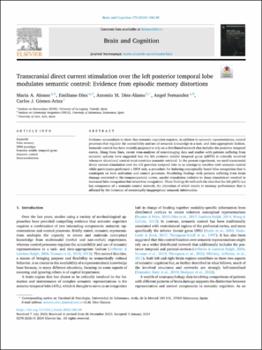Transcranial direct current stimulation over the left posterior temporal lobe modulates semantic control: evidence from episodic memory distortions
Fecha
2024Resumen
Evidence accumulates to show that semantic cognition requires, in addition to semantic representations, control
processes that regulate the accessibility and use of semantic knowledge in a task- and time-appropriate fashion.
Semantic control has been recently proposed to rely on a distributed network that includes the posterior temporal
cortex. Along these lines, recent meta-analyses of neuroimaging data and studies with patients suffering from
semantic aphasia have suggested that the left posterior middle temporal gyrus (pMTG) is critically involved
whenever situational context must constrain semantic retrieval. In the present experiment, we used transcranial
direct current stimulation over the left posterior temporal lobe in an attempt to interfere with semantic control
while participants performed a DRM task, a procedure for inducing conceptually-based false recognition that is
contingent on both activation and control processes. Paralleling findings with patients suffering from brain
damage restricted to the temporoparietal cortex, anodal stimulation (relative to sham stimulation) resulted in
increased false recognition but intact true recognition. These findings fit well with the idea that the left pMTG is a
key component of a semantic control network, the alteration of which results in m






